The Flavor Masking Agents Market is estimated to be valued at USD 1.8 billion in 2025 and is projected to reach USD 2.6 billion by 2035, registering a compound annual growth rate (CAGR) of 3.8% over the forecast period.
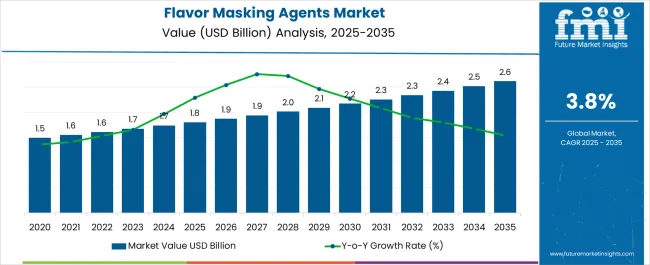
| Metric | Value |
|---|---|
| Flavor Masking Agents Market Estimated Value in (2025 E) | USD 1.8 billion |
| Flavor Masking Agents Market Forecast Value in (2035 F) | USD 2.6 billion |
| Forecast CAGR (2025 to 2035) | 3.8% |
The Flavor Masking Agents market is experiencing significant growth, driven by increasing demand from the food and beverage industry for improved taste profiles and consumer acceptance of functional, fortified, and nutraceutical products. The market is benefiting from rising health awareness, which has led to greater use of bitter or off-flavored ingredients such as vitamins, protein isolates, and plant-based compounds that require masking for palatability. Innovations in formulation science, including the development of natural and non-artificial masking agents, are enhancing product versatility and compatibility across a range of applications.
The market outlook is also supported by growing urbanization, higher disposable incomes, and the expansion of processed and packaged foods in emerging economies. In addition, the increasing trend of personalized nutrition and functional beverages is fostering demand for flavor masking technologies that can improve taste without altering nutritional value.
Manufacturers are investing in research and development to create multi-functional agents capable of masking multiple flavor profiles, ensuring scalability and applicability across different formulations As product innovation continues, the market is poised for steady growth with expanding opportunities in both developed and developing regions.
The flavor masking agents market is segmented by product type, end use, sales channel, and geographic regions. By product type, flavor masking agents market is divided into Sweet, Salt, Fat, Bitter, and Other. In terms of end use, flavor masking agents market is classified into Food & Beverage Industry, Meat & Meat Products, Dairy-Based Products, Bakery And Confectionery, Alcoholic Beverages, Pharmaceuticals, Nutraceutical Supplements, and Sport Nutrition. Based on sales channel, flavor masking agents market is segmented into Direct Sales/B2B, Indirect Sales/B2C, Intermediate/Bulk Distributors, Brick & Mortar Retailers, and Online Retailers. Regionally, the flavor masking agents industry is classified into North America, Latin America, Western Europe, Eastern Europe, Balkan & Baltic Countries, Russia & Belarus, Central Asia, East Asia, South Asia & Pacific, and the Middle East & Africa.
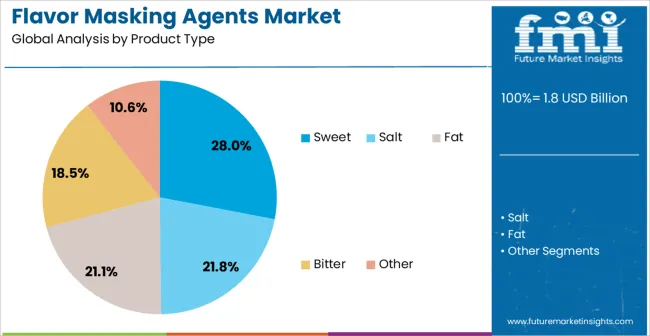
The Sweet product type segment is projected to hold 28.0% of the Flavor Masking Agents market revenue share in 2025, making it the leading product type. This dominance is being driven by the extensive use of sweet masking agents in food and beverage applications, where they effectively neutralize bitter, sour, or off-tastes while maintaining consumer-preferred flavor profiles. Growth in this segment has been supported by rising incorporation of functional ingredients such as proteins, fibers, and plant extracts that often require masking to enhance palatability.
The ease of formulation, stability under varying processing conditions, and compatibility with natural and artificial sweeteners have further strengthened adoption. Manufacturers are increasingly favoring sweet masking agents due to their ability to improve the sensory experience without impacting the nutritional content of end products.
Additionally, the segment has benefitted from strong adoption in ready-to-drink beverages, confectionery, and dairy alternatives, where consumer taste preferences play a critical role As demand for clean label and naturally flavored products continues to rise, the Sweet product type is expected to maintain leadership, supported by innovations that allow broader application across complex formulations.
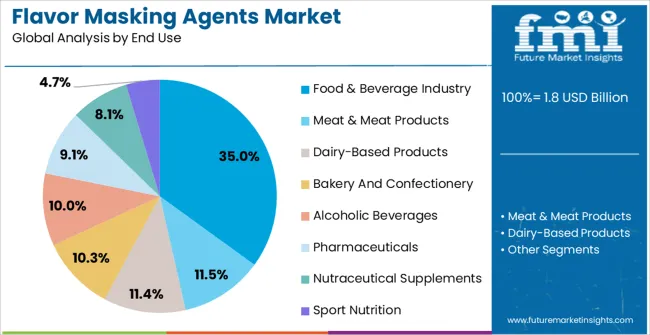
The Food & Beverage Industry end use segment is anticipated to account for 35.0% of the Flavor Masking Agents market revenue share in 2025, making it the largest segment in terms of end use. This leading position is being attributed to the widespread adoption of flavor masking agents to improve the taste of functional foods, fortified beverages, dietary supplements, and protein-enriched products. Growth in this segment has been supported by increasing consumer awareness of health and wellness, which has prompted manufacturers to fortify products with vitamins, minerals, and plant-based compounds that often have undesirable flavors.
The integration of masking agents allows for enhanced product acceptance without compromising nutritional value or quality. Additionally, the rise of processed and packaged food consumption in both developed and emerging markets has reinforced the demand for effective taste modulation solutions.
Flavor masking agents provide formulators with flexibility to achieve consistent taste profiles across a variety of applications, including dairy, beverages, confectionery, and bakery products As consumer preferences continue to shift towards healthier, functional, and fortified options, the Food & Beverage Industry segment is expected to remain the primary driver of market growth.
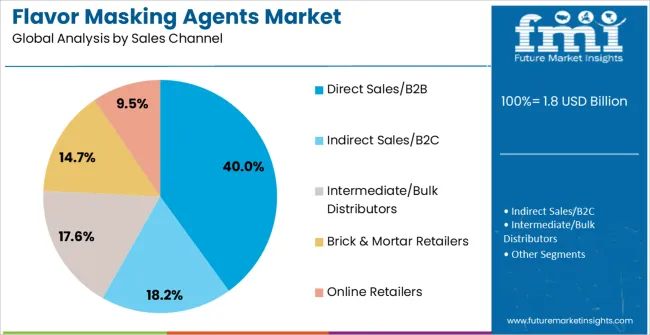
The Direct Sales/B2B sales channel segment is expected to capture 40.0% of the Flavor Masking Agents market revenue share in 2025, emerging as the leading distribution channel. This dominance is being driven by strong relationships between manufacturers and large-scale food and beverage producers, where bulk procurement and customized solutions are prioritized. Growth in this segment has been reinforced by the increasing complexity of formulations, requiring close collaboration between ingredient suppliers and end-product manufacturers to ensure optimal functionality and taste masking efficacy.
Direct sales channels allow manufacturers to provide technical support, application guidance, and regulatory compliance assistance, which are critical for the successful deployment of masking agents in diverse product lines. Furthermore, B2B arrangements facilitate tailored solutions for large-scale production, ensuring consistent quality and reliability.
The segment benefits from long-term contracts and repeat business, which enhance market stability and predictability As manufacturers continue to expand production capacities and explore innovative formulations, the Direct Sales/B2B channel is expected to sustain its leadership, offering strategic value in terms of customer engagement, customization, and technical service support.
Chemical reactions that flavor-masking substances cause make taste disappear. It has the power to soften bitterness and salinity. Additionally, it covers up the bitter flavors of some hydrolyzed proteins and additional dietary ingredients found in pet and animal feed. A food product's bitterness, glycerin flavor, vitamin and mineral flavor, and metallic flavor are concealed by an additive that provides the finished product an enticing flavor. The rising consumption of processed foods is to blame for the market rise of taste masking chemicals.
Flavor masking substances are used to improve a product's flavor by either providing a more enjoyable taste or covering up an unpleasant taste. Inactive chemicals called flavor masking agents are employed in the pharmaceutical sector. Inactive ingredients, which are typically the active medicine, are parts of a medication that do not improve or change the therapeutic function of the active ingredient. Flavoring agents, binding agents, preservatives, and buffers are a few examples of necessary addition inactive components.
In our new study, ESOMAR-certified market research and consulting firm Future Market Insights (FMI) offers insights into key factors driving demand for Flavor Masking Agents.
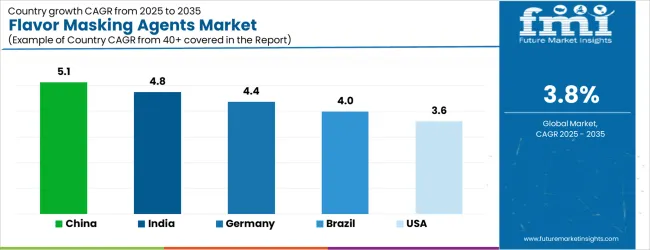
| Country | CAGR |
|---|---|
| China | 5.1% |
| India | 4.8% |
| Germany | 4.4% |
| Brazil | 4.0% |
| USA | 3.6% |
| UK | 3.2% |
| Japan | 2.9% |
The Flavor Masking Agents Market is expected to register a CAGR of 3.8% during the forecast period, exhibiting varied country level momentum. China leads with the highest CAGR of 5.1%, followed by India at 4.8%. Developed markets such as Germany, France, and the UK continue to expand steadily, while the USA is likely to grow at consistent rates. Japan posts the lowest CAGR at 2.9%, yet still underscores a broadly positive trajectory for the global Flavor Masking Agents Market. In 2024, Germany held a dominant revenue in the Western Europe market and is expected to grow with a CAGR of 4.4%. The USA Flavor Masking Agents Market is estimated to be valued at USD 659.0 million in 2025 and is anticipated to reach a valuation of USD 659.0 million by 2035. Sales are projected to rise at a CAGR of 0.0% over the forecast period between 2025 and 2035. While Japan and South Korea markets are estimated to be valued at USD 85.9 million and USD 53.5 million respectively in 2025.
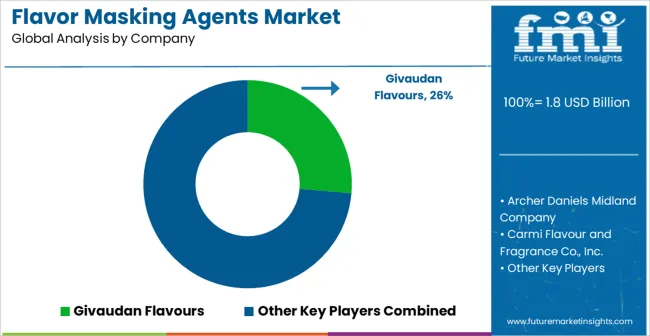
| Item | Value |
|---|---|
| Quantitative Units | USD 1.8 Billion |
| Product Type | Sweet, Salt, Fat, Bitter, and Other |
| End Use | Food & Beverage Industry, Meat & Meat Products, Dairy-Based Products, Bakery And Confectionery, Alcoholic Beverages, Pharmaceuticals, Nutraceutical Supplements, and Sport Nutrition |
| Sales Channel | Direct Sales/B2B, Indirect Sales/B2C, Intermediate/Bulk Distributors, Brick & Mortar Retailers, and Online Retailers |
| Regions Covered | North America, Europe, Asia-Pacific, Latin America, Middle East & Africa |
| Country Covered | United States, Canada, Germany, France, United Kingdom, China, Japan, India, Brazil, South Africa |
| Key Companies Profiled | Givaudan Flavours, Archer Daniels Midland Company, Carmi Flavour and Fragrance Co., Inc., Keva Flavours Pvt. Ltd., Roquette Freres, Sensient Technologies LLC, GEO Specialty Chemicals, DSM, Cargill Inc., Symrise AG, FCI Flavours, and Firmenich International SA |
The global flavor masking agents market is estimated to be valued at USD 1.8 billion in 2025.
The market size for the flavor masking agents market is projected to reach USD 2.6 billion by 2035.
The flavor masking agents market is expected to grow at a 3.8% CAGR between 2025 and 2035.
The key product types in flavor masking agents market are sweet, salt, fat, bitter and other.
In terms of end use, food & beverage industry segment to command 35.0% share in the flavor masking agents market in 2025.






Our Research Products

The "Full Research Suite" delivers actionable market intel, deep dives on markets or technologies, so clients act faster, cut risk, and unlock growth.

The Leaderboard benchmarks and ranks top vendors, classifying them as Established Leaders, Leading Challengers, or Disruptors & Challengers.

Locates where complements amplify value and substitutes erode it, forecasting net impact by horizon

We deliver granular, decision-grade intel: market sizing, 5-year forecasts, pricing, adoption, usage, revenue, and operational KPIs—plus competitor tracking, regulation, and value chains—across 60 countries broadly.

Spot the shifts before they hit your P&L. We track inflection points, adoption curves, pricing moves, and ecosystem plays to show where demand is heading, why it is changing, and what to do next across high-growth markets and disruptive tech

Real-time reads of user behavior. We track shifting priorities, perceptions of today’s and next-gen services, and provider experience, then pace how fast tech moves from trial to adoption, blending buyer, consumer, and channel inputs with social signals (#WhySwitch, #UX).

Partner with our analyst team to build a custom report designed around your business priorities. From analysing market trends to assessing competitors or crafting bespoke datasets, we tailor insights to your needs.
Supplier Intelligence
Discovery & Profiling
Capacity & Footprint
Performance & Risk
Compliance & Governance
Commercial Readiness
Who Supplies Whom
Scorecards & Shortlists
Playbooks & Docs
Category Intelligence
Definition & Scope
Demand & Use Cases
Cost Drivers
Market Structure
Supply Chain Map
Trade & Policy
Operating Norms
Deliverables
Buyer Intelligence
Account Basics
Spend & Scope
Procurement Model
Vendor Requirements
Terms & Policies
Entry Strategy
Pain Points & Triggers
Outputs
Pricing Analysis
Benchmarks
Trends
Should-Cost
Indexation
Landed Cost
Commercial Terms
Deliverables
Brand Analysis
Positioning & Value Prop
Share & Presence
Customer Evidence
Go-to-Market
Digital & Reputation
Compliance & Trust
KPIs & Gaps
Outputs
Full Research Suite comprises of:
Market outlook & trends analysis
Interviews & case studies
Strategic recommendations
Vendor profiles & capabilities analysis
5-year forecasts
8 regions and 60+ country-level data splits
Market segment data splits
12 months of continuous data updates
DELIVERED AS:
PDF EXCEL ONLINE
Flavoring Agents Market Size and Share Forecast Outlook 2025 to 2035
Flavoring Cosmetic Formulation Agents Market Size and Share Forecast Outlook 2025 to 2035
Flavor Modulator Market Size and Share Forecast Outlook 2025 to 2035
Masking Tape Market Size and Share Forecast Outlook 2025 to 2035
Flavor Emulsions Market Size and Share Forecast Outlook 2025 to 2035
Flavor Modulators Market Size and Share Forecast Outlook 2025 to 2035
Flavor Compounds Market Size and Share Forecast Outlook 2025 to 2035
Flavored Whiskey Market Size and Share Forecast Outlook 2025 to 2035
Flavored Butter And Oils Market Size and Share Forecast Outlook 2025 to 2035
Flavoring Oils Market Size and Share Forecast Outlook 2025 to 2035
Flavors for Pharmaceutical & Healthcare Applications Market Size and Share Forecast Outlook 2025 to 2035
Flavor Capsule Cigarette Market Analysis - Size, Share, and Forecast 2025 to 2035
Flavored Syrup Market Analysis - Size, Share, and Forecast Outlook 2025 to 2035
Masking Paper Market Analysis by Product Type, Basis Weight, Paper Grade, Application, End Use, and Region through 2025 to 2035
Analysis and Growth Projections for Flavor and Flavor Enhancers Market
Flavored Yogurt Market Analysis by Form, Flavor, End Use and Distribution Channel Through 2035
Flavors and Fragrances Market Analysis by Type, Nature, Application, and Region through 2035
Flavor Emulsion Market Analysis by Nature, End-Use, Distribution Channel, and Region - Growth, trends and forecast from 2025 to 2035
Flavored CBD Powder Market Growth - Innovations & Consumer Trends 2025 to 2035
Flavored Salt Market Insights - Seasoning Trends & Growth 2025 to 2035

Thank you!
You will receive an email from our Business Development Manager. Please be sure to check your SPAM/JUNK folder too.
Chat With
MaRIA